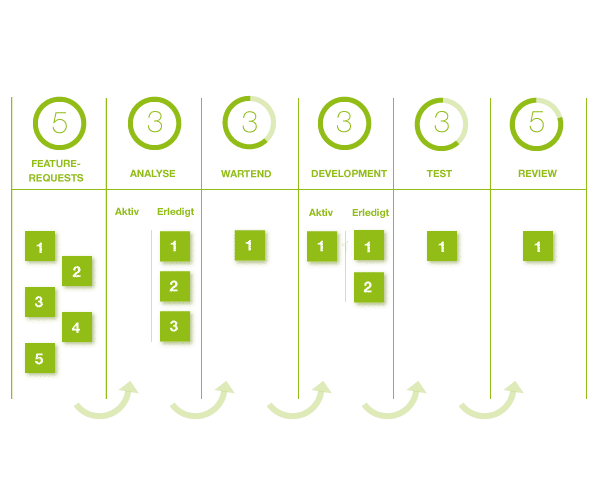
How does an app project actually happen?
As so often in life, the answer is: It depends.
Let’s look at a new project.
This is where we begin from scratch, a true greenfield project. But instead of long grass and meadow flowers, think coffee and mind maps. We establish the steps we need to take, we analyse the existing infrastructure, get to know your users and together develop a clear goal.
We work with the Scrum method using an agile approach. That means that we’ll present you with the pre-defined milestones in snack size—or as “sprints”—and then work forwards with clearly defined steps.
We’ll come up with a software architecture concept and blueprint for you. And if necessary we’ll develop prototypes, or proof of concept: So that it’s passed the reality test well before we get started on development. This is important in cases where, for example, new hardware needs to be added into the mix. Even if your concept is ahead of its time an extra level of insurance can’t hurt.
Every two weeks (at the very least) we’ll hold sprint meetings and discuss the next phase of the project.
If your app already exists
When we take over already existing code, we first need to acclimatise ourselves to the concept and architecture. The other questions are generally the same as for new apps: What will the users use the app for? What are its strengths and what are its weaknesses? We analyse the status quo and give you feedback before going forwards. After that, the project environment will define our next steps. If there are only individual changes to make or error corrections, then we suggest using the Kanban method of project management. Apart from this, the process is pretty much the same as the development of a new app.
Whether it’s a new app or an already existing project, we hold to the same standards: continuous integration, automated builds, distribution through test distributors and stores or automated tests. That doesn’t say a lot to you? We’re more than happy to explain everything in person.


What does a long-term project look like?
We love to accompany projects from the beginning until… well, until when? We love to have clients with whom we can work together over a number of years. The release plan is the tool of choice to achieve a long-term project.
We work with you to establish important milestones, nurturing the growth of the app with the use of sprint goals and transparency. This is where we profit from our agile management. But for us, the release doesn’t mean the end of our work. An app must continue to work over time and follow developing trends. For this reason maintenance budgets should always be included in the initial project calculation.
Assured quality tailored to you
Quality tests and a structured acceptance process are very important but don’t necessarily belong in every phase of development. And every project, product and app has its own unique requirements.
Sometimes it’s important to regularly check general quality; sometimes it’s better to focus on individual important changes. In another project it might be better to build a prototype and to make sure that it has heart and soul.
And some tasks require a line-by-line, seamless cover through unit tests and a comprehensive integration suite.
The following key questions make for a good starting point:
- Does the app work on different devices?
- With different operating systems?
- In numerous versions and with individual settings (Keyword: Accessibility)?
- Is the app stable?
- What about storage space, battery time or poor network connection?
It’s important to keep an app stateof-the-art, since they are downloaded and installed, unlike websites which can be continually optimised. Even an update in the Store can take days to happen, so the version that’s delivered needs to be highly capable and not suffer from dropouts or interruptions.





